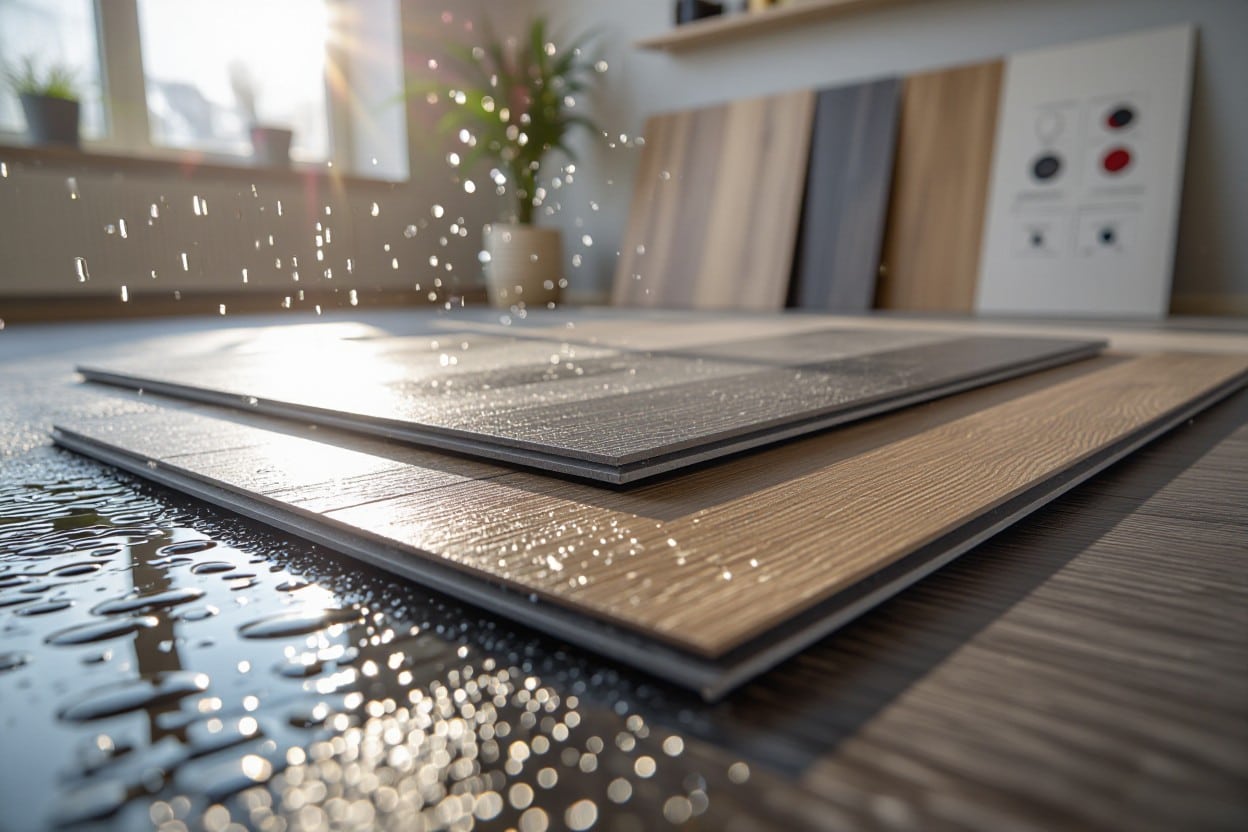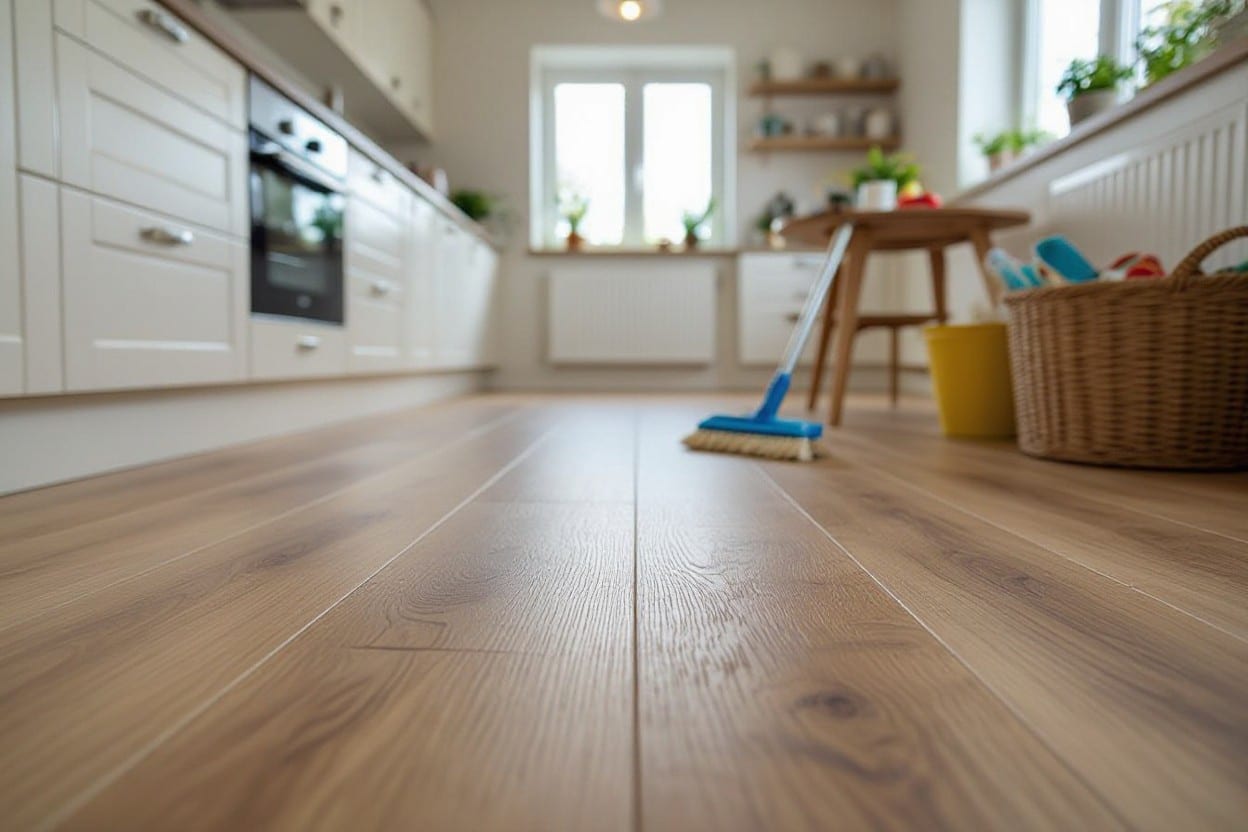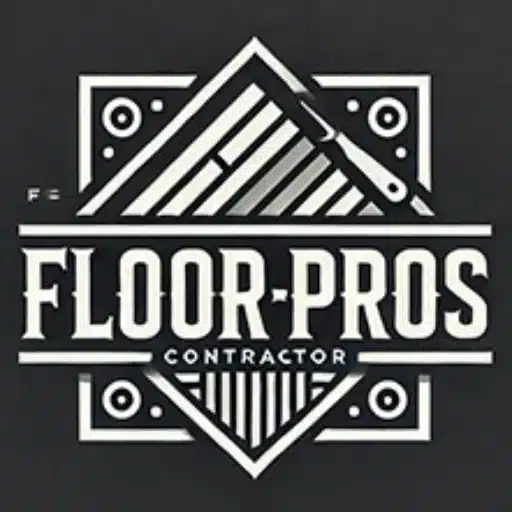What 7 Secrets Make Vinyl Flooring Remarkably Durable?
When it comes to floors that can withstand life’s daily wear and tear, vinyl flooring stands out as one of the most durable options available. At Floors Pros, we’ve seen homeowners across Allen and surrounding areas choose vinyl not just for its style, but for its unbeatable durability. With the right construction, protective layers, and simple care, vinyl flooring can look fresh for years—even in busy homes. Let’s walk through the seven secrets that make vinyl flooring remarkably durable.
The Robust Construction: Layers That Shield
Multi-layer builds give vinyl flooring its backbone: a clear wear layer, printed design layer, rigid or flexible core, and a stabilizing backing. Compare products; vinyl flooring with thicker wear layers and dense cores resists scratches and fading longer. You can weigh trade-offs—luxury vinyl plank for realism, LVT for tight installations, and sheet vinyl for seamless water control—so your selection matches the traffic and moisture demands.
The Shielding Power of Wear Layers
Wear layers, measured in mils, provide surface protection: 6–12 mil fits low-traffic rooms, 12–20 mil suits busy homes, and 20+ mil handles commercial use. On your vinyl flooring, urethane or aluminum-oxide coatings reduce scuffs and staining, while ceramic-enhanced coatings boost abrasion resistance. Top-rated vinyl flooring lines often publish abrasion-cycle data—check that lab information against expected wear.
Core Stability: The Role of Backing Materials
Core choices—SPC, WPC, flexible vinyl—define stiffness, dent resistance, and installation limits. SPC cores deliver rigid strength and moisture tolerance so your vinyl flooring stays flat in basements and entryways. WPC adds warmth and cushion but trades some dimensional stability. Match core type to subfloor flatness, traffic loads, and whether you’ll use underfloor heating to prevent cupping or gaps.
SPC cores typically range 3–7 mm and give high compressive strength, while WPC often spans 4–8 mm with more underfoot give; thicker cores (6–8 mm) reduce hollow sound and flex over imperfect substrates. Manufacturer testing shows that rigid cores withstand heavy rolling loads and humidity swings. Therefore, choose a core and backing combination that keeps your vinyl flooring stable, dent-resistant, and quiet underfoot.

Resilience Against Nature: Water and Temperature Resistance
Many vinyl flooring products feature waterproof cores and dense wear layers, allowing your floors to withstand spills and seasonal fluctuations. You have rigid-core vinyl flooring options, such as SPC and WPC, that resist warping and are durable. Additionally, you have 100% waterproof sheet formats suitable for basements and bathrooms. The wear layers, typically 6–20 mil, protect printed visuals. Installers normally recommend 48 hours of acclimation to minimize movement.
| Resilience Snapshot | Waterproof cores, 6–20 mil wear layers, SPC/WPC stability, 48-hour acclimation |
Water-Resistant Innovations in Vinyl Design
Manufacturers have engineered vinyl flooring with 100% waterproof cores and welded seams on sheet options, allowing you to use them in bathrooms and basements. The rigid SPC cores, featuring limestone filler, resist moisture and denting. Surface treatments, such as UV-cured polyurethane and ceramic bead topcoats, enhance scratch and stain resistance, while integrated underlayment improves sound quality and reduces subfloor moisture transfer for long-term performance.
| Waterproof Features | SPC/WPC cores, 100% waterproof sheets, UV-cured PUR, welded seams, attached underlayment |
Temperature Control: How Vinyl Adapts
Allow the vinyl flooring to acclimate for 48 hours at the room’s normal temperature—typically 60–80°F—so that the boards settle and gaps remain predictable. Leave expansion gaps (often 1/4″) at perimeters and every long run to prevent buckling; rigid-core vinyl flooring shifts less than traditional LVT under thermal swings, giving you stable surfaces in sunlit rooms and across seasonal cycles.
| Temperature Tips | Acclimate 48 hrs, 60–80°F install temp, 1/4″ expansion gaps, SPC more stable than LVT |
Underfloor heat works with many vinyl flooring lines if you keep the surface below about 85°F (29°C) and avoid abrupt temperature spikes; gradual increases and a compatible adhesive or floating installation prevent delamination. Test subfloor output, follow manufacturer limits, and run a moisture and temperature check before installation to protect your warranty and long-term performance.
| Radiant Heat Guidelines | Max surface ≈85°F (29°C), gradual temp changes, verify subfloor heat, follow manufacturer specs |
The Science of Longevity: Advanced Manufacturing Techniques
Multi-layer construction, precision lamination, and heat-stable cores extend service life. A clear wear layer, high-definition décor film, and a rigid backing work together to resist abrasion, stains, and dimensional changes. You gain when wear layers reach 12–20 mil and UV-cured urethane or ceramic-bead finishes are applied; lab tests show that thicker wear layers, combined with SPC or WPC cores, keep vinyl flooring performing well over a decade under typical household use.
- Wear-layer engineering: 6–20 mil options; higher mil equals longer life for vinyl flooring.
- Core technology: SPC and WPC cores improve dimensional stability and moisture resistance in vinyl flooring.
- Printing & embossing: high-resolution décor layers with register embossing reduce visible wear and scuffing.
- Precision finishing: UV-cured coatings and texturing add scratch resistance and ease of maintenance.
Manufacturing Techniques Breakdown
| Technique | Benefit |
|---|---|
| UV-cured urethane finish | Significantly increases abrasion resistance for vinyl flooring |
| Ceramic-bead / aluminum oxide topcoat | Boosts scratch and scuff resistance for vinyl flooring |
| Wear-layer thickness control | 12–20 mil options rated for high-traffic residential and commercial use |
The Role of PVC Technology in Durability
Advanced PVC formulations utilize higher molecular-weight resins and targeted plasticizer packages to reduce creep and enhance impact resistance, resulting in floors that resist indentation from heavy furniture and point loads. Manufacturers also incorporate stabilizers that limit UV breakdown, providing vinyl flooring with improved long-term color and dimensional stability in rooms exposed to sunlight.
Cutting-Edge Finish Options Enhancing Wear Resistance
Modern finishes combine UV-cured urethane with ceramic or aluminum-oxide particles to create micro-armor surfaces that shed scratches and scuffs while keeping maintenance simple, letting you clean without abrasive scrubbing and preserving the visual texture and gloss of your vinyl flooring.
Additional systems layer multiple thin coatings with different properties—one for slip resistance, another for chemical resistance—so you can choose LVT with a 20-mil wear layer plus an aluminum-oxide surface for commercial kitchens or a 12-mil urethane-plus-ceramic finish for busy homes, matching performance to your traffic patterns and warranty needs.
Life-Proofing Your Floors: Scratch and Dent Defense
Layering a thick wear layer and a hard, transparent coating gives your vinyl flooring real resilience. A 12–20 mil wear layer suits busy homes, while a 20–30 mil wear layer stands up to light commercial use. You’ll see fewer scratches from chairs and pet claws when manufacturers add urethane or ceramic-bead topcoats. Combined with rigid cores like SPC and routine cleaning, the right vinyl flooring keeps appearance and function under daily traffic for years.
Understanding the Scratch-Resistant Coatings
Urethane finishes fortified with ceramic-bead particles create microscopic shields that disperse abrasion, helping your vinyl flooring resist scratches from pet nails and movement of furniture. Manufacturers often apply 1–2 coats of enhanced urethane, plus a UV-cured clear coat; commercial lines sometimes add aluminum oxide. You can compare abrasion results: higher mil wear layers and ceramic-reinforced coatings outperform basic vinyl flooring in standardized scratch and wear tests.
How Dent-Resistant Properties Elevate Performance
Rigid cores, such as SPC (stone polymer composite), drastically reduce indentation, allowing your vinyl flooring to withstand heavy furniture and high heels. Two millimeters of dense core material reduces visible dents compared to flexible plank options commonly found in luxury vinyl plank (LVP) products. You’ll prefer SPC in kitchens and entryways, while WPC offers added comfort with a slightly more flexible feel. Choose vinyl flooring with reinforced backing and thicker wear layers to spread point loads from castor wheels and appliance feet.
Vinyl flooring dent resistance can be evaluated by checking core thickness (commonly 3–7 mm for rigid products) and wear layer dimensions—rigid 4–5 mm SPC cores paired with 20–30 mil top layers show markedly less indentation in busy environments. Installers report that commercial venues using 5 mm SPC with a 20 mil wear layer have maintained unmarred surfaces for years under restaurant seating and rolling carts. Therefore, your vinyl flooring, matched to those specs, reduces repair cycles and keeps floors flat and safe.

Maintenance Magic: Simple Upkeep for Lasting Beauty
Daily Care Strategies That Extend Life
Sweep or vacuum daily with a soft-brush head to remove grit that scratches the wear layer; use a microfiber mop for light cleaning and a neutral cleaner diluted per label. Place commercial-grade doormats and felt pads under furniture legs; rearrange rugs occasionally to avoid uneven fading. Avoid steam cleaners and abrasive pads. Following these simple steps extends the life of vinyl flooring and keeps your surface looking new—especially in high-traffic kitchens and entryways where vinyl flooring faces the most wear.
Deep Cleaning: Best Practices for Vinyl Floors
Schedule deep cleans every 1–3 months, depending on the level of traffic. Start by vacuuming resilient vinyl flooring with a soft-brush attachment, then mop with a pH-neutral solution specifically labeled for resilient floors. You can prevent finish breakdown by avoiding ammonia, bleach, or oil-based soaps. For commercial-grade and modern vinyl flooring, choose maintenance products that match the wear-layer rating; excessive water or high-heat steam can cause seams to lift. Proper products help preserve color and reduce micro-scratches on vinyl flooring over the years of use.
Start with a step-by-step method: use a dry-vac to remove grit, then damp-mop your vinyl flooring with one cup of pH-neutral cleaner per gallon of warm water or a manufacturer-recommended concentrate. Avoid soaking seams. Tackle scuffs with a microfiber pad and a baking-soda paste, rinse and dry thoroughly. For glue or oil spots, use isopropyl alcohol on a soft cloth, testing first. These steps help keep luxury vinyl flooring looking factory-fresh and preserve the wear layer on vinyl flooring.
The Economic Argument: Value Beyond Initial Investment
You get upfront savings because vinyl flooring often runs $2–$7 per sq ft installed versus $8–$15 for hardwood; lower material and installation costs mean faster payback. Choosing luxury vinyl flooring for kitchens and entryways gives you wear layers of 12–20 mil and warranties up to 25 years, so your floor resists dents and stains and keeps value longer.
Cost-Effectiveness of Durable Vinyl Flooring
Calculate total cost per square foot over 20 years: durable vinyl flooring typically costs $2–$7 installed and needs minimal maintenance—occasional mopping and a $30 cleaner—while hardwood can require $1,000+ refinishing. You can save 40–60% on upkeep when you pick vinyl flooring with a thicker wear layer, especially in moisture-prone spaces.
Long-Term Savings Through Reduced Replacement Rate
Higher-grade luxury vinyl flooring can last 20–25 years in residential settings and up to 10–15 years in commercial settings, resulting in reduced replacement cycles compared to carpet (7–10 years) and low-end laminate (10–15 years). You avoid teardown and disposal costs, and warranties often cover wear, so your total replacements drop substantially over a building’s lifetime. Choosing vinyl flooring with a 20-mil wear layer reduces replacements in active households.
A case study of a 5,000 sq ft boutique found that switching from carpet tile to commercial-grade luxury vinyl flooring (20-mil wear layer) cut replacement and maintenance costs by 48% over a decade; carpet required replacement twice while the vinyl only needed targeted plank swaps and a reseal in year 10. When you factor in reduced labor—installation costs drop from $3–$5 per sq ft for carpet to $1.50–$3 for vinyl flooring—and lower downtime, the lifecycle ROI becomes clear. Warranty coverage, lower disposal fees, and fewer scheduled overhauls typically translate to thousands saved per room over 15–20 years.
Wrapping Things Up
Vinyl flooring has earned its reputation as one of the most durable and versatile flooring options available today. From waterproof cores and scratch-resistant finishes to easy upkeep and long-lasting warranties, it offers real value for both homes and businesses. At Floors Pros, we help families and property owners across Allen find the right vinyl flooring option—whether that’s vinyl plank, vinyl tile, or luxury vinyl. With expert installation and the right product, you can count on vinyl flooring to deliver strength, beauty, and comfort for years to come.
FAQs
Q: What are the seven secrets that make vinyl so durable?
A: Here are seven key reasons that give vinyl flooring its long life: a thick wear layer that resists scratches; tough surface coatings like UV-cured urethane or ceramic bead; a stable core option (SPC or WPC) that prevents dents and warping; waterproof construction that blocks moisture; tight locking or strong adhesive installation that keeps seams closed; scratch and stain resistant top finishes; and low-maintenance care that removes grit. When choosing vinyl flooring, look for clear wear-layer specs, a strong finish, and a solid core for heavy use.
Q: How does the wear layer protect the floor?
A: The wear layer is the clear top film that takes the abuse — scuffs, foot traffic, and dirt. On vinyl flooring, this layer is measured in mils; higher mil counts mean more resistance in busy rooms. Finishes like urethane or ceramic bead increase scratch and stain resistance. For homes with pets or heavy use, opt for a thicker wear layer and a reinforced top coat for enhanced longevity.
Q: Do different core types matter for longevity?
A: Yes. Rigid cores such as SPC and WPC add stability and dent resistance. Some rigid vinyl flooring resists heavy loads and keeps planks flat in high temperatures and direct sunlight. Flexible sheet vinyl is softer and can be more prone to impact marks. Good core design reduces expansion, ensuring the floor remains even under furniture and rolling chairs. Good manufacturing quality helps any vinyl flooring perform better over time.
Q: How does installation affect durability?
A: Proper installation keeps water, gaps, and movement from causing damage. Click-lock systems, tight glue-down seams, or fully welded edges make the surface stable and less likely to lift. A correct underlayment evens subfloor imperfections and reduces point stress. With correct fit and sealed seams, vinyl flooring stays flat and watertight longer.
Q: How should I care for it to make it last?
A: Sweep or vacuum daily to remove grit, mop with a damp cloth and a pH-neutral cleaner, and avoid abrasive pads or harsh chemicals. Use felt pads under furniture, mats at entrances, and keep pet nails trimmed. If you have heavy traffic, pick a vinyl flooring with UV-cured urethane or a commercial-grade wear layer. Daily care and simple protection keep vinyl flooring looking new for many years.
Q: Is vinyl tile flooring a good choice for kitchens and bathrooms?
A: Yes, vinyl tile flooring is water-resistant and easy to clean, making it perfect for kitchens, bathrooms, and laundry rooms. It’s also budget-friendly and comes in a wide range of designs that mimic the look of ceramic or stone.
Q: How does laminate vs vinyl flooring compare in durability?
A: Both are popular, but when it comes to moisture resistance and long-term durability, vinyl flooring generally outperforms laminate. Laminate is less tolerant of water spills, while vinyl can be fully waterproof, making it better for high-traffic and moisture-prone areas.
Q: What’s the difference between vinyl sheet flooring and vinyl plank flooring?
A: Vinyl sheet flooring comes in large, continuous rolls that create seamless coverage, great for bathrooms and basements. Vinyl plank flooring and luxury vinyl plank flooring are individual boards designed to resemble wood, offering a more realistic texture and easier plank replacement if needed.
Ready to upgrade to durable, stylish floors that fit your lifestyle? At Floors Pros, we specialize in vinyl plank flooring, vinyl tile flooring, vinyl sheet flooring, and luxury vinyl plank flooring, along with expert installation services for all flooring types. Call us today or visit our showroom to explore the best vinyl flooring options—we’ll make sure your new floors look beautiful and last for years.
What are the Top 5 Reasons to Choose Hardwood Flooring?
